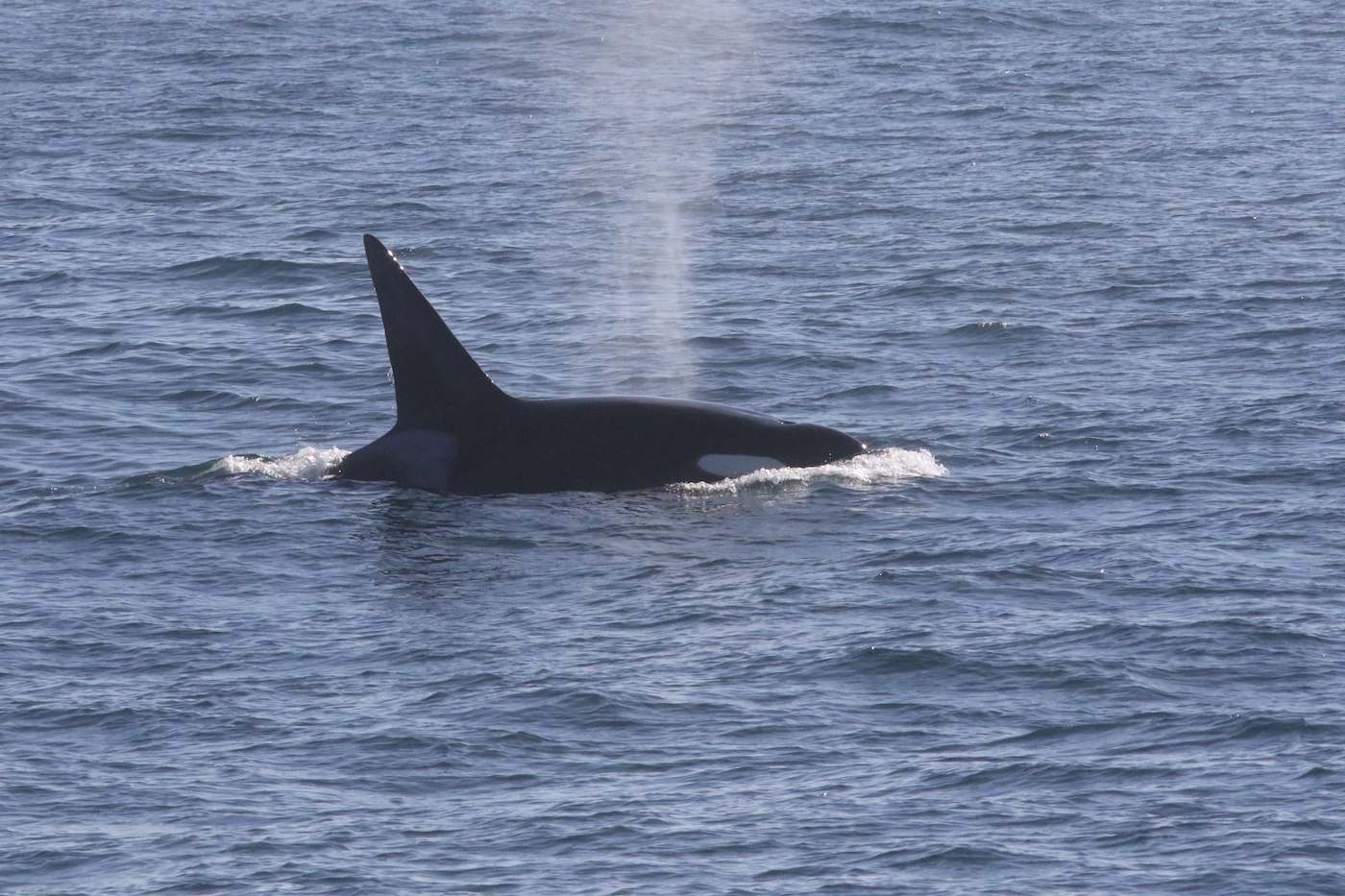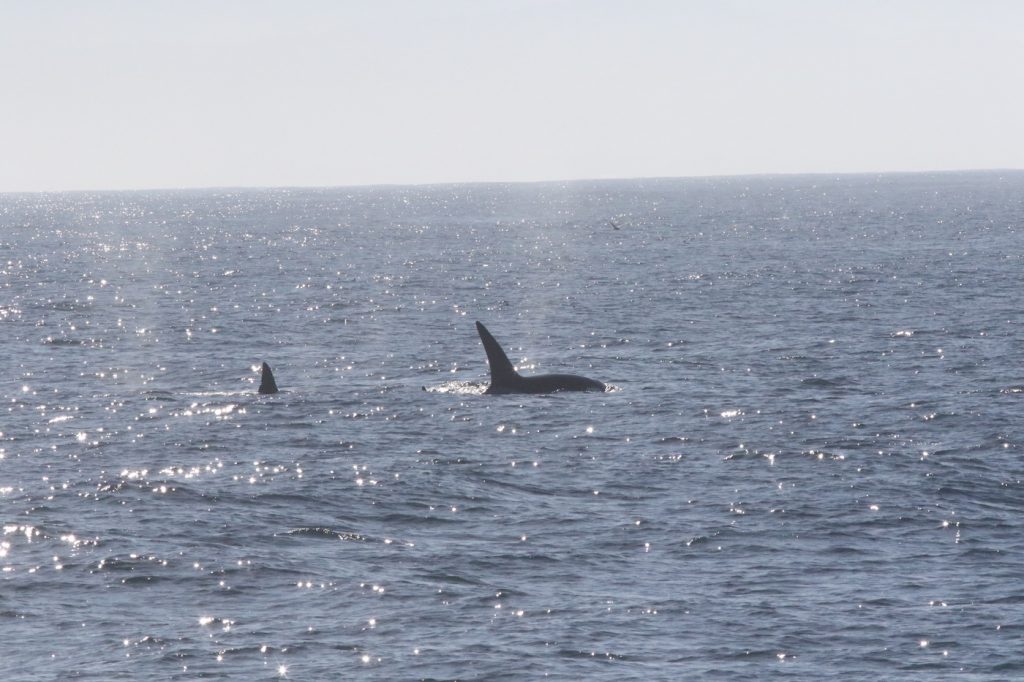Family Bonds

There was no denying the six-foot-tall dorsal fin cutting through the open ocean above the Soquel Canyon State Marine Conservation Area within the teeming waters of Monterey Bay, along the Central California Coast.
Black and steeple-shaped, the dorsal fin belonging to a mature, male orca glistened in the morning sun. This apex predator is known as Ben. A quarter mile off the bow of the whale-watching boat, his plume of mist shot out of his spout as did the rest of the other orcas in the pod, an array of seabirds circling above.
There were four orcas in all, and Ben’s mother was on hand as well. Her name is Emma. The other two orcas were her offspring, and as of this writing it is not known if they are males or females and thus far, they are unnamed. They are part of an orca pod known as CA140. Orca culture is that of a matriarchal society. The moms rule the roost, and their sons stay with their mothers their whole lives. They are mamma boys.
Wanderers
There are no resident orca pods in Central and Southern California. Resident pods rely on a specific food source like salmon. Instead, transient pods maraud the offshore waters feasting on whales, dolphins, seals, and sea lions. They travel constantly in search of marine mammals, and sightings of orcas in the Santa Barbara Channel do not happen often. Whereas in Monterey Bay they are seen frequently.
Monterey Bay is sometimes referred to as a “Pelagic Serengeti.” That is due to the super deep, underwater canyon inside the bay reaching 1,000 to 6,000 feet down. Cold upwelling currents stirred by consistent northwest winds swirl upward towards the surface carrying tons of zooplankton and phytoplankton, satiating a throng of pelagic species. Therefore, food is aplenty for predators like orcas that reign at the top of the food web.
Emma and her pod were not hunting when we came across them. They were merely surfacing and moving at a gradual pace, slicing southward through the calm waters like a porpoise.
The last time I saw Emma and her pod was two years prior in the Santa Barbara Channel. I was returning from Santa Cruz Island after several days of guiding kayak trips through toothy sea caves. So, whenever traveling to and from the islands there’s always a slim chance of experiencing something amazing.
Emma was with her younger brother Liner. He was born in 1990 and is 32 years old. Emma was born in 1981. She is 41 years old. The pod was traveling through choppy seas to the west, perhaps out to Point Bennett on San Miguel Island, where the largest seal and sea lion congregation in the world takes place.
Female orcas in the wild can reach 75 to 100 years old. Males generally live 50 to 70 years. Generally, males don’t do as well after a mother passes.
CKWP
The California Killer Whale Project (CKWP) is a nonprofit devoted to all things orca, including their complex life histories and conservation up and down the California Coast. The nonprofit has taken the responsibility of archiving documentation dating back to the 1950s and continuing the collection of data with their commitment to those transient orcas.

To identify pods and individuals within those groups, biologists look for blemishes in their white eye and saddle patches, and on their impressive dorsal fins. For example, Emma from the CA140s possesses an E-shaped notch on the backside of her dorsal fin. Another male orca from the CA51s is known as Bumper, a proper name for an orca with a noticeable bump or warble in his dorsal fin.
The CKWP gathers their data from scientists, naturalists, photographers, fishermen, and the like. They observe each pod’s travels and behaviors and document their lives in the offshore waters off the coast.
I remember back in 2012 photographing the CA51s in the East Santa Barbara Channel off Santa Cruz Island. It was before 11 am. By the end of the day the CA51s had gathered on the southeast side of Point Bennett where an abundant food source awaits any predator. There are six different species of pinnipeds that utilize that active, year-round rookery smack dab in the middle of the California Current.
Stealthy Cetaceans
There were several whale-watching vessels enjoying Emma and members of the CA140s that early November day in Monterey Bay. The pod seemed to be in no big hurry to hunt. Instead, they basked in the sun while constantly changing directions.
They would surface, and then stay down for several moments before revealing themselves with their majestic spout, plumes wafting skyward on the immediate horizon. The boats would then maneuver carefully toward the pod keeping a safe distance not to disturb them.
Arguably, the most intelligent mammal on the planet, when orcas don’t want to be seen or socialize, they can ghost a flotilla of whale watching boats like no other cetacean. From bow to stern, every passenger on each boat kept an eye, but the CA140s had vanished from view in the dark depths of Monterey Bay.







You must be logged in to post a comment.